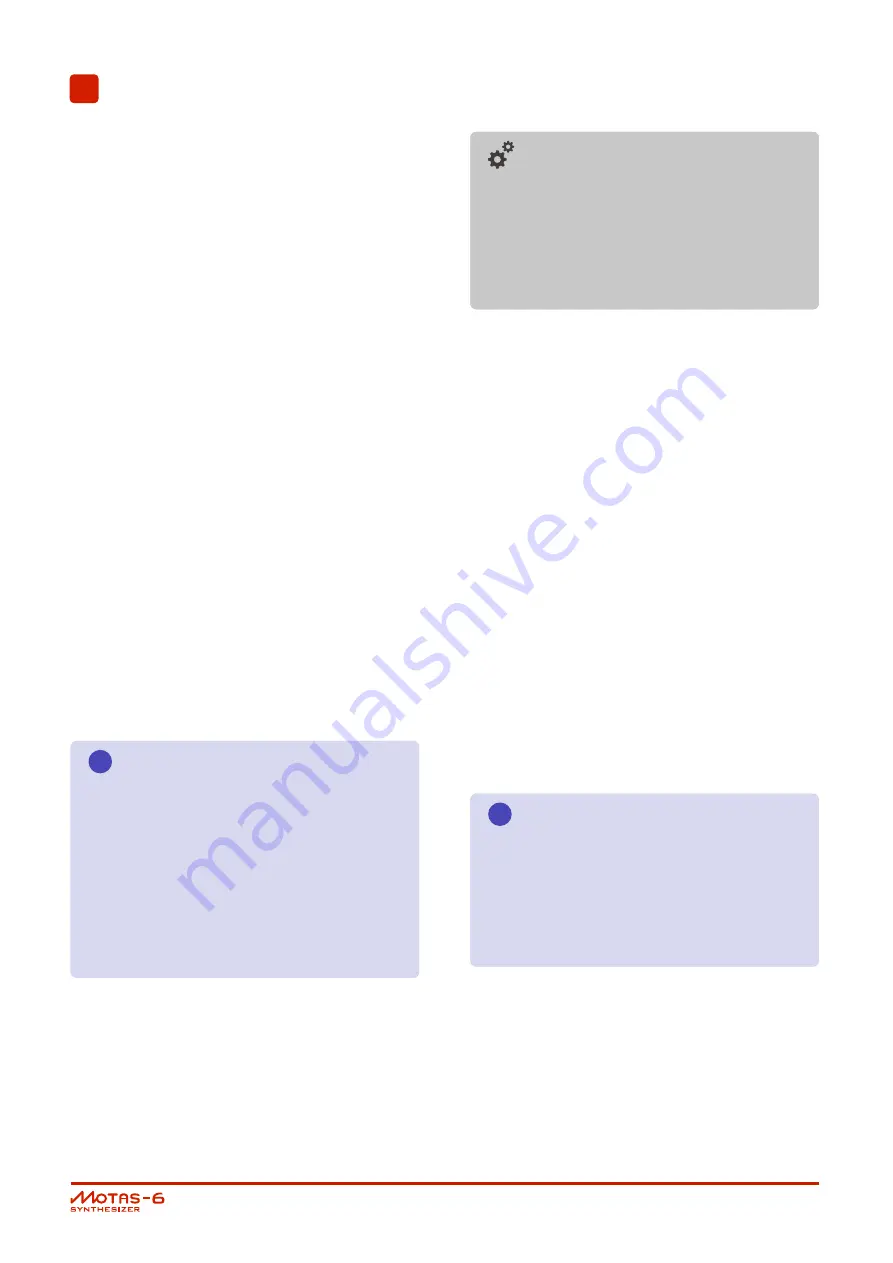
9
Modulation
Modulation means changing parameter values from a mod-
ulation source. This could be a freely-changing modula-
tion with time, such as from a low-frequency oscillator (LFO)
that is not synchronised or modulation that is synchronised
to the start of a key press, such as from an envelope gen-
erator (EG) triggered by a note-on event.
Conventional analogue synthesizers typically have a small
number of LFOs and EGs (usually 1 or 2) that are used for
modulation. In some cases the modulation sources have
fixed destinations (such as a dedicated EG for output level)
or can be set to only a limited number of destinations (such
as filter cut-off frequency or pitch).
MOTAS-6 is different –
every
parameter has its own dedi-
cated LFO and dedicated EG in addition to dedicated mod-
ulation amount settings from velocity, pitch, 4 global LFOs,
4 global EGs and 4 definable global modulation sources
(MIDI, CV or global LFOs/EGs)! This powerful architecture
allows complete freedom to modulate and control almost
every aspect of the sound generation. You can freely set
the modulation for every parameter separately if desired
or have coupled modulation between parameters using the
global modulation sources, if you wish.
Each parameter page allows you to set the levels and rout-
ings of the various parameters that determine the sound,
but things get a lot more interesting once some modu-
lation is used. Modulation allows creation of interesting
sounds that change in character over time.
i
[INFO] Perhaps the most common ’modu-
lation’ used in synthesizing sounds (and often not
really considered as modulation) is simply applying
an envelope modulation to the output signal level.
With this ’modulation’ the volume increases once a
key is pressed and decays away once the key is re-
leased. Without this modulation a constant sound
volume would be heard whether or not a key was
pressed, which would be used for a ’drone’ sound
patch.
[ADVANCED-INFO] In addtion there is the
advanced modulation feature that interacts across
all of the parameter pages. This powerful feature
allows complex chains of modulation from many
sources to be applied to a vast choice of destina-
tions. See section
and the
for
more details.
Each and every parameter page has dedicated modulation
control amounts from 9 sources:
NOTE
MIDI/CV note-on value
VELOCITY/ACCENT
MIDI/CV note velocity
M1
global modulation M1
M2
global modulation M2
M3
global modulation M3
M4
global modulation M4
GLOBAL LFO-X
choice of global LFO x = 1–4
LOCAL-LFO
dedicated LFO for
each parameter page
EG
choice of global EG x = 1 – 4, or
dedicated EG
The modulation amount can be zero (for no modulation),
positive or negative. The actual modulation signal applied
to the parameter page value is the product (i.e. multiplica-
tion) of the modulation amount and the modulation source
signal at that point in time. All of the modulation signals
are added together with the parameter page basic offset
value to give the resulting value for the parameter page
value.
i
[INFO] The modulations can be set to either
a ’bipolar’ or ’unipolar’ response (except for the
LFOs which are fixed in ’bipolar’ reponse). Bipo-
lar means that when the source is at its mid-value
the modulation effect will be zero whilst in unipo-
lar mode the effect is zero when the source is also
at its zero value.
User Guide v1.31 [FOR SCREENREADERS]
page 12
Summary of Contents for Motas-6
Page 2: ......
















































